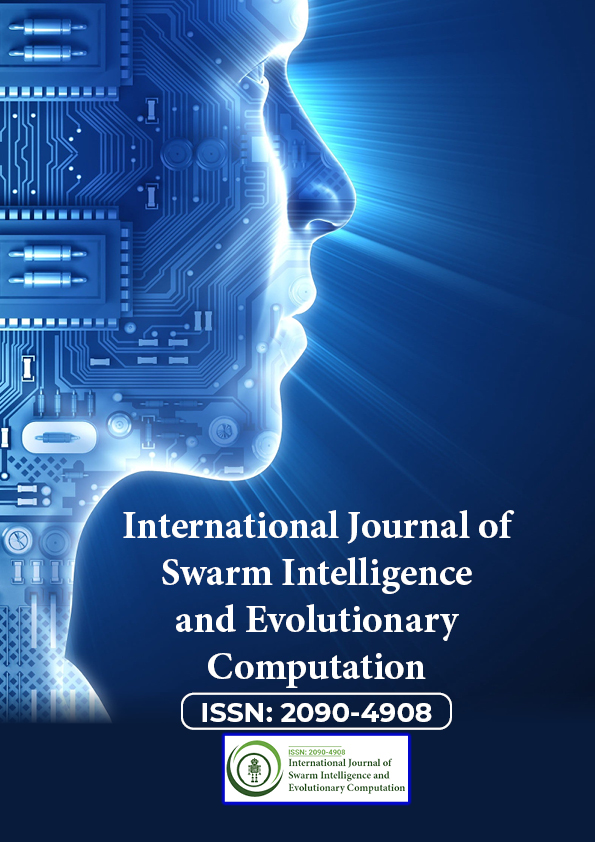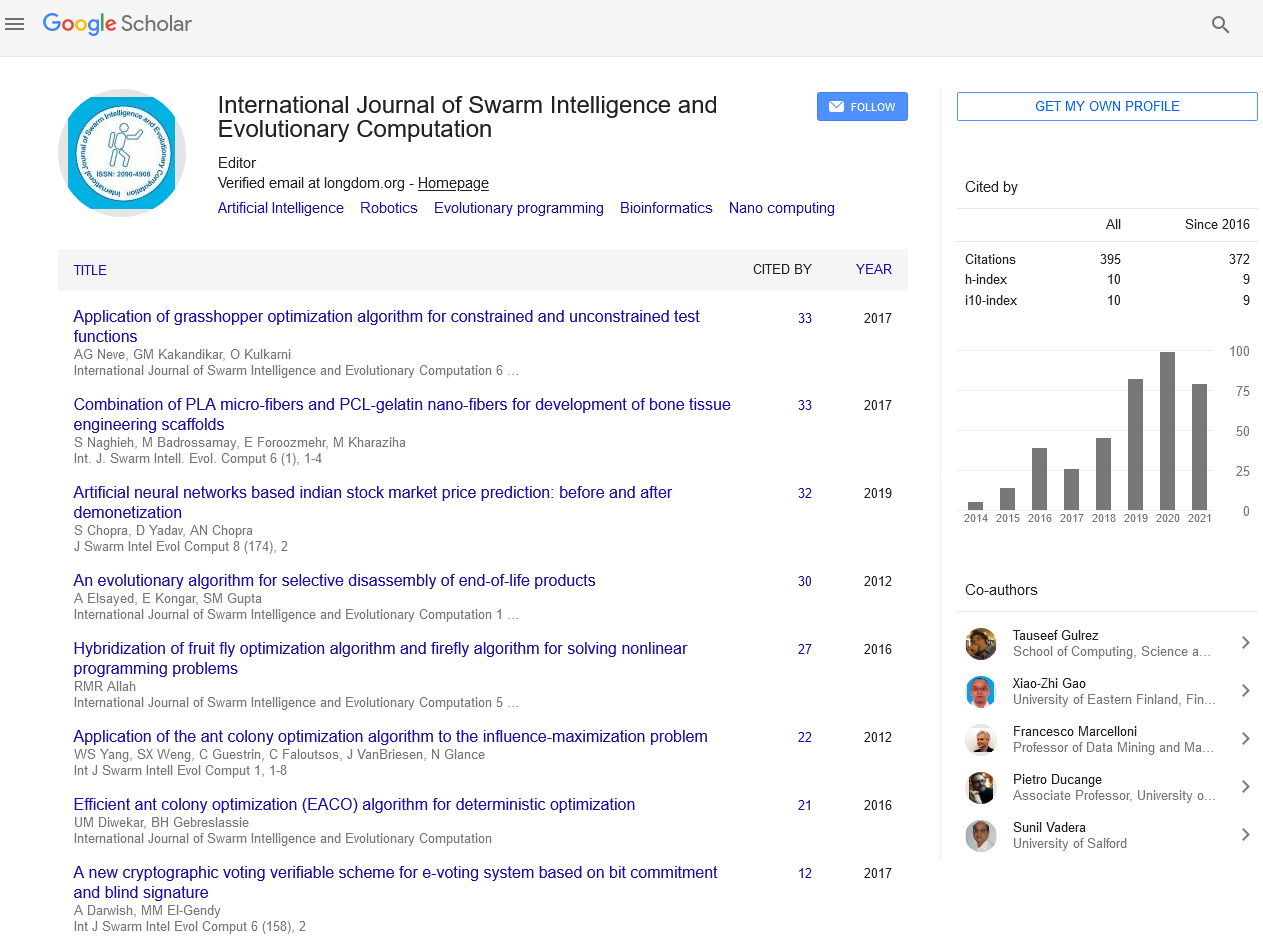Indexed In
- Genamics JournalSeek
- RefSeek
- Hamdard University
- EBSCO A-Z
- OCLC- WorldCat
- Publons
- Euro Pub
- Google Scholar
Useful Links
Share This Page
Journal Flyer

Open Access Journals
- Agri and Aquaculture
- Biochemistry
- Bioinformatics & Systems Biology
- Business & Management
- Chemistry
- Clinical Sciences
- Engineering
- Food & Nutrition
- General Science
- Genetics & Molecular Biology
- Immunology & Microbiology
- Medical Sciences
- Neuroscience & Psychology
- Nursing & Health Care
- Pharmaceutical Sciences
Commentary - (2024) Volume 13, Issue 5
Self-Organization and its Impact on Multi-Objective Optimization
Hedhibi Boubaker*Received: 26-Aug-2024, Manuscript No. SIEC-24-27462; Editor assigned: 28-Aug-2024, Pre QC No. SIEC-24-27462 (PQ); Reviewed: 11-Sep-2024, QC No. SIEC-24-27462; Revised: 18-Sep-2024, Manuscript No. SIEC-24-27462 (R); Published: 25-Sep-2024, DOI: 10.35248/2090-4908.24.13.395
Description
Optimization problems often involve finding the best possible solution from a set of possible alternatives, with multiple conflicting objectives. These problems, known as Multi- Objective Optimization (MOO), are common in real-world scenarios such as resource allocation, engineering design and finance. Traditional optimization methods, which aim to optimize a single objective, do not apply well when multiple objectives must be considered simultaneously. In such cases, selforganizing systems, which are inspired by natural processes, offer a promising approach to solve these complex problems.
Self-organization, a process where complex structures emerge from simple local interactions between components, can provide powerful mechanisms to address multi-objective optimization. By leveraging the principles of self-organizing systems, multiobjective optimization algorithms can examine the tradeoffs between divergent objectives and find a set of solutions that balance these trade-offs effectively.
Multi-objective optimization involves optimizing two or more conflicting objectives, where improving one objective can lead to the deterioration of another. For example, in product design, a designer may want to minimize both cost and weight while maximizing performance. Finding a solution that satisfies all objectives simultaneously is impossible because improving one typically compromises the others.
Self-organization in multi-objective optimization
Self-organizing systems offer an innovative way to tackle multiobjective optimization problems. These systems operate without a centralized control structure, and the behavior of the system emerges from the local interactions between its components. In the context of optimization, self-organizing algorithms enable individual agents or solutions to examine the solution space, exchange information and adapt based on local feedback. Over time, these interactions lead to the emergence of effective solutions that balance the conflicting objectives.
Self-organizing systems do not rely on a central decision-maker. Instead, individual agents or solutions make local decisions based on their current state and the information they receive from other agents. This decentralized nature allows for greater flexibility and scalability in exploring large solution spaces, which is particularly important in multi-objective optimization.
Self-organizing systems can adapt to changing environments and dynamically adjust their behavior based on the evolving conditions of the optimization problem. In multi-objective optimization, this adaptability enables solutions to continuously adjust their trade-offs between objectives as they examine the solution space.
Inspired by the behavior of bird flocks, PSO uses a population of particles (potential solutions) that move through the solution space. Each particle adjusts its position based on its previous experience and the best solution found by its neighbors. In multi-objective optimization, PSO can be modified to consider multiple objectives simultaneously, and particles are guided by the Pareto dominance principle to find a diverse set of solutions that approximate the Pareto front.
ACO is inspired by the foraging behavior of ants, which find the shortest path to food by leaving pheromone trails that other ants follow. In multi-objective optimization, ACO agents search the solution space and deposit pheromones on promising solutions, guiding future agents to examine areas with better trade-offs between objectives. Over time, the collective behavior of the ants converges toward an optimal or near-optimal set of solutions.
Self-organizing algorithms scale effectively as the problem size increases. As the number of objectives or the dimensionality of the problem grows, self-organizing systems can examine the solution space efficiently by employing decentralized, parallel search strategies.
Self-organizing systems are inherently robust to changes in the problem environment. As multi-objective optimization problems often involve dynamic or uncertain conditions, the adaptability of self-organizing algorithms allows them to adjust to these changes and continue analyzing the solution space effectively.
One of the key challenges in multi-objective optimization is maintaining diversity in the set of solutions. Self-organizing systems naturally encourage diversity by allowing solutions to evolve independently and cooperate with one another. This helps generate a diverse set of solutions along the Pareto front, providing decision-makers with multiple alternatives that balance the trade-offs between objectives.
Self-organization offers a powerful approach to solving multiobjective optimization problems, providing the ability to examine large solution spaces, adapt to dynamic conditions, and maintain diversity in solutions. By integrating decentralized, cooperative and adaptive principles, self-organizing algorithms can find a diverse set of Pareto-optimal solutions, allowing decision-makers to navigate complex trade-offs between conflicting objectives. As these algorithms continue to evolve, they will play an increasingly important role in optimizing real-world systems across various domains, from engineering and finance to healthcare and beyond.
Citation: Boubaker H (2024). Self-Organization and its Impact on Multi-Objective Optimization. Int J Swarm Evol Comput. 13:395.
Copyright: © 2024 Boubaker H. This is an open-access article distributed under the terms of the Creative Commons Attribution License, which permits unrestricted use, distribution, and reproduction in any medium, provided the original author and source are credited.


